A spectacular submarine cliff over 100 metres high – the Cathedral Escarpment- marked the front of the algal limestones of the Cathedral Formation. The Cathedral Escarpment was initially thought to be a product of prolific algal growth and sediment accumulation during a period of sea level rise. A re-interpretation suggested that the escarpment is the headwall of a regional slide scar, where the over-steepened front of the Cathedral Formation collapsed into the basin shales. In either case, the Cathedral Formation carbonates are older than the adjacent mudstones of the Stephen Formation.
Over approximately two million years, the Stephen Formation mudstones filled the basin in front of the escarpment, and eventually covered the Cathedral limestone when sea level rose. The Stephen Formation mudstones are much thinner on top of the escarpment than the mudstones in front of it; They are referred to as the Thin Stephen, and Thick Stephen, respectively. The Cathedral Escarpment marks this change in thickness and it can be traced across much of Yoho National Park and Kootenay National Park.

Revised for web format from “A Geoscience Guide to the Burgess Shale” by Murray Coppold and Wayne Powell, © The Burgess Shale Geoscience Foundation. To purchase this book, please go to: the Yoho National Park Visitors Centre, Alpine Book Peddlers, Amazon.ca, or Amazon.com

